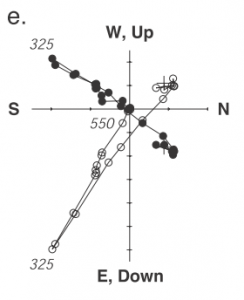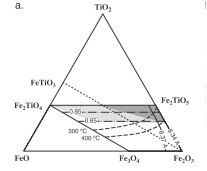I am afraid this post is a little delayed. The paper we discussed at the end of June was: Alteration and self-reversal in oceanic basalts, Doubrovine & Tarduno, 2006. A companion paper, well worth a look at is: Self-Reversal magentization carried by titanomaghemite in oceanic basalts, Doubrovine & Tarduno (2004).
I chose this paper because of some intriguing results I’ve had working on my Archean aged samples. I was keen to hear what the lab had to say about the paper above, but also about my results and self-reversals in general, as they are pretty controversial due to being quite poorly understood.
It has been suggested, since the late 1950s, that given the right conditions, some oceanic basalts can carry a self-reversed chemical remanent magnetisation (CRM). Research by Verhoogen (1956) suggested that self-reversals could occur in titanomagnetites by ionic reordering during low-temperature oxidation. Oceanic basalts are good candidates because seafloor weathering is characterised by low-temperature oxidation of titanomagnetites as show by Bleil & Petersen, 1983, amongst others. However, it was not until the research published in Doubrovine & Tarduno, 2004, that a clear example of this process was identified and so, little research into self-reversals was conducted during the 1990s.
Research by Verhoogen (1956) suggested that self-reversals could occur in titanomagnetites by ionic reordering during low-temperature oxidation. Oceanic basalts are good candidates because seafloor weathering is characterised by low-temperature oxidation of titanomagnetites as show by Bleil & Petersen, 1983, amongst others. However, it was not until the research published in Doubrovine & Tarduno, 2004, that a clear example of this process was identified and so, little research into self-reversals was conducted during the 1990s.
In oceanic basalts, oxidation occurs by the removal of iron due to interaction with sea water or sea water bearing fluids. Self-reversals occur at a critical degree of oxidation when it is possible for cation vacancies created at tetrahedral sites (A magnetic sublattice) to migrate into the octahedral sublattice, via diffusion. This process is known as Ionic Reordering . It allows single domain grains (and perhaps also pseudosingle domain grains) that carry a CRM by titanomagnetite to transform into an antipodal CRM. I recommend you take a look at the two papers if you want to understand this process more fully, they’ve got some good formulas which might help!
Verhoogen (1956) reported a large range of titmanomagnetite compositions were this process might be possible (light grey area in theTiO2-FeO-Fe2O3 diagram), but O’Reilly & Banerjee (1966) showed that Verhoogen’s (1956) cation distribution was unrealistic and indicated that self-reversals were only possible in titanomaghemite, (dark grey area in theTiO2-FeO-Fe2O3 diagram). In addition, work by Schult (1968, 1971) shows that ionic reordering should produce N or Q-type thermomagentic behaviour.
(light grey area in theTiO2-FeO-Fe2O3 diagram), but O’Reilly & Banerjee (1966) showed that Verhoogen’s (1956) cation distribution was unrealistic and indicated that self-reversals were only possible in titanomaghemite, (dark grey area in theTiO2-FeO-Fe2O3 diagram). In addition, work by Schult (1968, 1971) shows that ionic reordering should produce N or Q-type thermomagentic behaviour.
The work by Doubrovine & Tarduno (2004,2006) suggests that the compositional field in which true self-reversals can occur, as proposed by O’Reilly & Banerjee (1966) is too broad and that the range is in fact, much more restricted than previously though. The work presented in the paper suggests that the very high oxidation states and high Ti contents are required to produce a true self-reversals negates the possibility of it being a common occurrence in oceanic basalts. The authors suggest that self-reversal is indicative of unusual ocean floor conditions such as extreme fluid flow and iron removal.
Selected References
Bleil, U., and N.Peteresen (1983), Variations in magnetization intensity and low-temperature titanomagnetite oxidation of ocean floor basalts, Nature, 301, 384-388.
O’Reilly, W,. and S.K. Banerjee (1966), Oxidation of titanomagnetites and self-reversal, Nature, 211 (5044), 26-28
Schult, A. (1968), Self-reversal of magnetization and chemical composition of titanomagnetites in basalts, Earth Planet Sci. Lett., 4, 57-63.
Verhoogen,J. (1956), Ionic reordering and self-reversal magnetization in impure magnetities. J.Geophys. Res., 61(2), 201-209

Leave a Reply